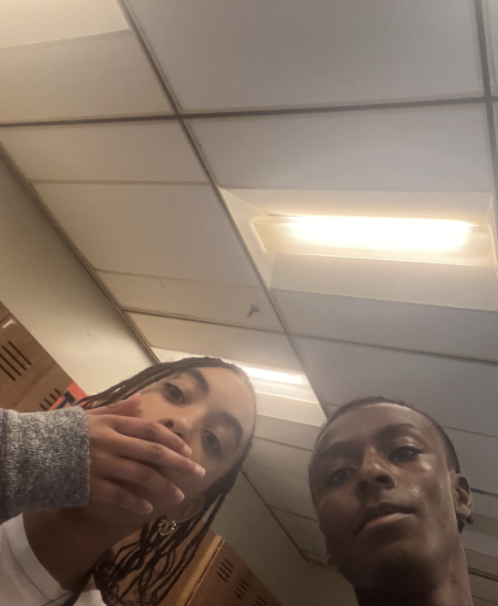Introduction
From observing the title of this post, you may be wondering, what is Camerawork? Camerawork notes the techniques and ways cameras are used in the production of a film. Studying those camera methods are key, because as, “7 Basic Camera Movements (And Why they matter), www.seenit.io,” states, “camera movement can add a lot of meaning to your footage, changing and shaping a viewer’s perspective of a scene.”
Considering what techniques to use while planning our group’s planning shots, we broke down camerawork into four categories, written in the title of this blog, such as shot size, camera angles, framing, and composition. Below, these elements of camerawork defined, to clear any confusion:
© -Shot size: Records specific parts of a subject.
Example: Establishing shot
-Camera Angles: The angle in which the camera is placed, while focusing on the subject.
Example: Dutch Angle
-Framing: The position of the camera directed at the number of subjects.
Example: Point-of-View Shot
-Composition: Visual arrangements in a camera frame.
Example: Depth of field
Sparked With Inspiration
On set, insuring all the elements above are included and properly executed in a film, a production team must have a cinematographer, otherwise known as photography director. One highly renowned, and among one of the most favored cinematographers by the public (myself included) is Bill Pope. For those who may not know, Bill Pope has collaborated on major film products in the film industry such as “the Matrix (1999),” and “the Jungle Book (2016),” in which are movies that have left significant impacts in Hollywood, still discussed until this day. As a result of these film’s overall positive receptions in the box office, he received countless awards such as a Primetime 2014 Creative Arts Emmy award, and a BAFTA Award for Best Cinematography.
My group and I intend to emulate Bill Pope and developing camerawork skills, because those skills provide inspiration for methods to use to emphasize elements of Mise-en-Scene we will produce in our film.
Shot 1:
A figure hides in the shadows, appearing to be a dark figure whose silhouette is barely distinguishable.
© Shot size: Establishing shot
© Camera angle: High Angle
© Framing: One Shot
© Composition: Depth of Field, Horizontal
©Tone: UnsettlingShot 2:
© Shot size: Master Shot
© Camera angle: Shoulder level
© Framing: Crowd Shot
© Composition: Leading Line
© Tone: Casual, lighthearted
Shot 3:
© Shot size: Wide Shot
© Camera angle: High Angle Shot
© Framing: Crowd Shot
© Composition: Leading Lines, and depth of field
© Tone: Calm
© Shot size: Full Shot
© Camera angle: Shoulder level
© Framing: Crowd Shot
© Composition: Shallow Focus, or soft, deep focus
© Tone: Concerned, impatient
© Shot size: Master Shot
© Camera angle: Shoulder level
© Framing: Three Shot
© Composition: Balance
© Tone: Ironic and humorous
© Shot size: Medium shot
© Camera angle: High level
© Framing: Single shot
© Composition: Lines
© Tone: Daring, Confident, and Dominant
© Shot size: Medium Shot
© Camera angle: Close Up
© Framing: Single shot
© Composition: Rule of Third, Depth of field, Shallow Focus
© Shot size: Medium Full shot
© Camera angle: Low Angle
© Framing: Two shot
© Composition: Balance
© Tone: Irreverent, Goofy
REFLECTION
During the production process for this assignment, our production team each contributed their own strengths into making our final product. Our team collaborated as directors, set designers, and camerapersons filming school, field trip, and home settings with people in our community and our surroundings acting, which made our project be complete and come together.
Our group purposefully arranged our shots to capture school and home locations, which reflect the genre that we are basing our movie on, which is the horror genre, or comedic, psychological horror sub-genre to be more specific. As a whole, we portrayed different social groups and settings in a humorous, or unsettling way conventionally found in the comedic, psychological horror genre.
For example, our first shot, established a dark, undistinguishable figure at the bottom of a flight of stairs. This was meant to create an unfamiliar, and unnerving atmosphere. Another example is our fifth shot, which showed contrast between an annoyed cheerleader who is surrounded by two happy, and upbeat cheerleaders, which is relative to paradoxes used in the comedy genre.
Using the shot sizes, camera angles, framing and composition that we chose made conveying our genre much easier, because subtle elements such as facial expressions, combined with atmosphere and mood, can have a significant impact on how a shot is perceived. Our teamwork, and overall uniting the camerawork skills we learned in this exercise has helped us to accomplish the goal of this assignment.
To explain, my dear and fellow teammates and I all each worked in areas of our personal expertise such as Peyton P brainstorming fresh, innovative approaches which shots to use, Marley B researching and planning how to capture our shots, and Lexi M, Peyton, and I oversaw photography.
We used our personal Camera app on our phones, and adjusted the quality and camera lenses to capture all the shots in this blog. Due to our regular occupation on our phones, we performed these camerawork skills at an expert level.
All in all, we learned the importance and impact of using camerawork in film, as well as key camerawork terms, which will help us in the near future during the production of our upcoming movie.
WORK CITED:
-Stennett, E. (2022). 7 Basic Camera Movements (And Why They Matter!). [online] Seenit. Available at: https://www.seenit.io/blog/6-basic-camera-movements-and-why-they-matter/.








No comments:
Post a Comment